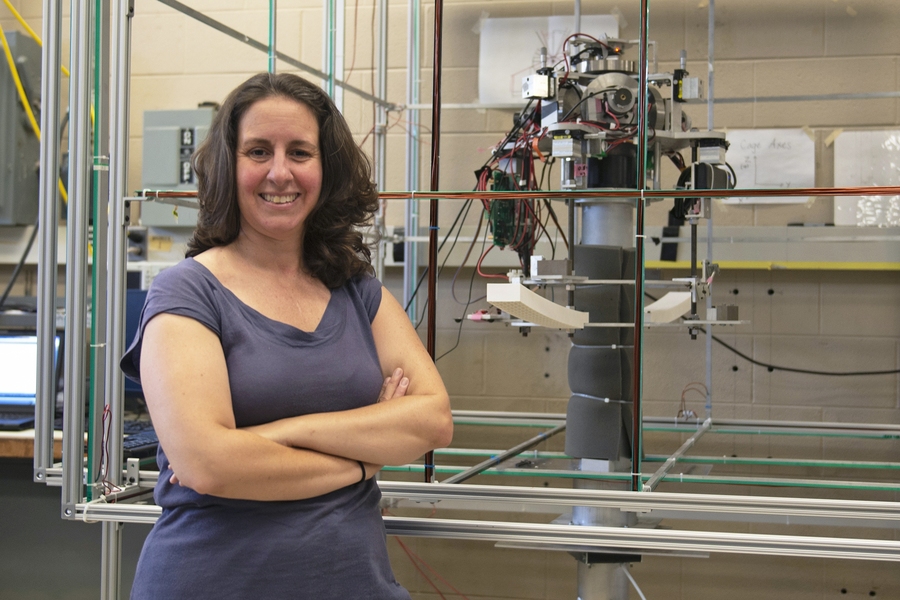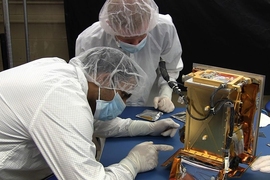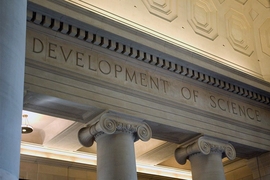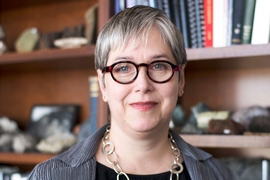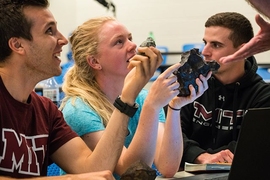MIT Department of Aeronautics and Astronautics (AeroAstro) researcher Rebecca “Becky” Masterson has much to be pleased about. A device she was instrumental in developing is aboard a spacecraft on a historic mission to a distant asteroid. And she's just been appointed as a principal research scientist for the department.
“Becky is an outstanding researcher with an impressive record of accomplishment in space systems engineering and design,” AeroAstro head Jaime Peraire says in his announcement of Masterson’s promotion from research engineer to principal research scientist. “She has played key technical and management roles in several projects involving sophisticated flight instrumentation and hardware, such as the REXIS project, where she served as program manager and co-PI, and more recently, the NASA TESS program, where she is a technical leader. Becky brings a unique expertise to the MIT community.”
“She is also a talented mentor and educator who, in true MIT fashion, brings together teams of graduate and undergraduate students working on real flight hardware, thus providing them with a unique experience,” Peraire adds.
MIT defines principal research scientists as those who “possess all the qualifications of research scientist, research engineer, or research associate and ... have demonstrated the ability to generate and develop concepts independently, and to conduct independent research.”
Of the Institute’s 115 principal researchers, 22 are women. Including Masterson, there are now four principal researchers in the AeroAstro department — and she is the first woman to earn this honor in the 104-year history of MIT aerospace engineering.
Being the first female in a role in 2018 “feels a bit overwhelming,” Masterson says. “It tells me that there is still work to be done supporting and mentoring young women engineers and researchers and making a place where they feel welcome,” she says. “I hope I can provide some of that encouragement and inclusivity on the research track.”
Professor of aeronautics and astronautics and MIT Institute Professor Sheila Windnall, who became MIT's first female engineering professor in 1964, calls Masterson “a tremendous MIT asset, as both a researcher and a teacher.”
“I am personally thrilled to congratulate her on becoming our first female PRS.” Windall says. “As it says in our department’s statement on diversity, our scholarship, teaching, and learning’s full potential only can happen in an environment where every individual is valued without prejudice, and where inclusion and collaboration is a core principle.”
David Miller, the Jerome Hunsaker Professor of Aeronautics and Astronautics and former director of the Space Systems Laboratory (SSL), where Masterson has worked since 2012, says Masterson provides “a perfect, yet rare combination of research prowess, real world experience, program management expertise, focus on education, and teamwork skills.”
“Her desire to keep one foot in education and research and her other foot in spaceflight programs provides her with a unique and exceptionally valuable perspective on the aerospace field,” Miller notes. “Hers is a perspective that isn’t traditionally provided in our classrooms and creates opportunities for our graduate researchers that are quite rare in the academic setting.”
On Sept. 8, 2016, NASA launched OSIRIS-REx (Origins, Spectral Interpretation, Resource Identification, Security-Regolith Explorer), a spacecraft with an unprecedented mission: to harvest a piece of the asteroid Bennu and return the extraterrestrial sample to Earth. Aboard the spacecraft is REXIS, an MIT and Harvard University student-built imaging spectrometer that will analyze the effect of the sun’s X-rays on the asteroid’s soil, identifying chemical elements on Bennu’s surface. REXIS may also assist in pinpointing a good spot for collecting the sample.
Masterson was a REXIS co-principal investigator.
“REXIS has been on its way to Bennu for two years,” Masterson says. “It turns on about every six months, and every time it does, I’m excited. This summer, we’ll be opening its cover, which is a big deal. We’ll take a look at the Crab Nebula and do some calculations before we do actual asteroid science in the summer of 2019.”
Prior to joining SSL, Masterson was a senior engineer at the Charles Stark Draper Laboratory in Cambridge, Massachusetts, where, among her tasks were flight control design and certification for Space Shuttle / International Space Station mated operations, and mission control support during space shuttle missions. She earned her BS, MS, and PhD degrees, all in mechanical engineering, from MIT in 1997, 1999, and 2005 respectively.
As a principal researcher, she’s now in a position to bring in her own grants. “Now I can more easily chart my own path,” she says. She notes that in her role as an engineering researcher, “I’m trying to find a balance between building things and publishing.”
Masterson also treasures the time she gets to spend with students.
“I really enjoy being in an academic environment,” she says. “Working with students is an interaction I wouldn’t have in industry. I’d hoped that the department would find my experience building and flying hardware beneficial to our students’ educational experience. My promotion says that yes, the department does.”
